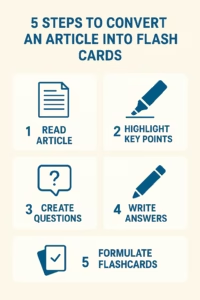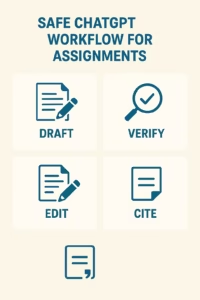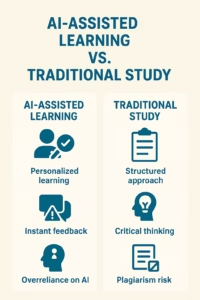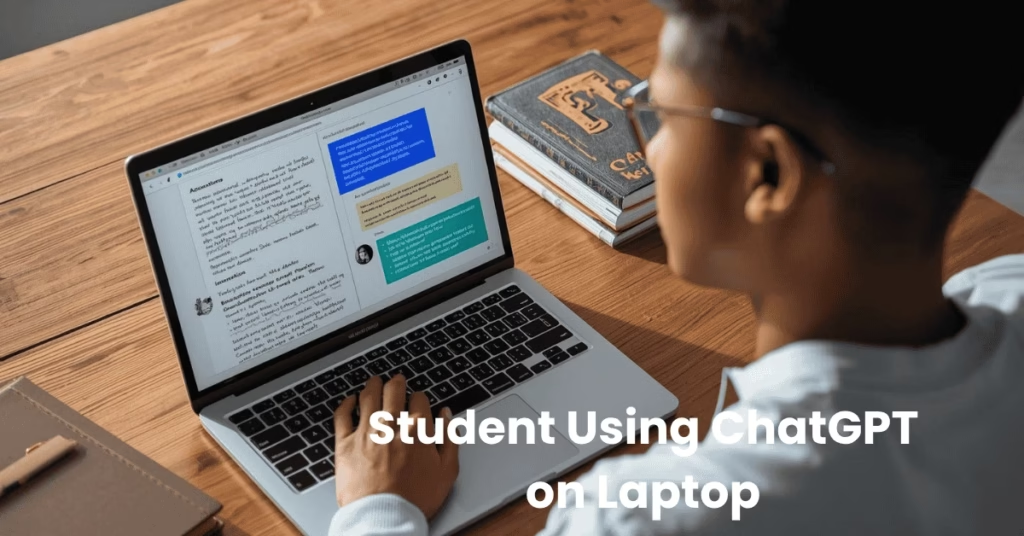Table of Contents
Introduction
ChatGPT for students: study guides, summaries, and academic risks is a practical guide that shows how learners can use ChatGPT to boost studying, create fast summaries, and avoid academic dangers. In this post you’ll learn real-world ways to get study guides and summaries from ChatGPT, plus how to manage academic risks when using AI tools. The tips are friendly, up-to-date, and geared to help students and educators adopt safe, effective practices.
ChatGPT for students ,Why this matters now
Generative AI (such as ChatGPT) is now readily accessible to students and teachers. It can accelerate note-taking, produce study guides, and develop summaries from lengthy readings — but it comes with danger: incorrect material, overuse, and academic-honesty problems. Several studies and university advisories present mixed results on learning and demand apparent rules and pedagogy. OpenAI+1
Quick overview
- Practical examples of using ChatGPT for study guides and summaries
- Step-by-step prompts that get better results
- How to spot and reduce academic risks (plagiarism, inaccuracies, privacy)
- 7-day action plan to integrate ChatGPT into your study routine
- SEO-friendly title, tags, meta description, featured image ideas, and CTAs
- Embedded external and internal references for further reading (including Mindliftly). OpenAI+1
1. How students can use ChatGPT for students: the practical toolbox
Here are the most effective ways students are actually employing ChatGPT today — with realistic prompts you can cut and paste and modify.
1.1 Study guides (scaffolded learning)
Utilize ChatGPT to design multi-layer study guides that start with high-level maps and drill down into specifics (definitions, explanations, sample questions, memory aids). Sample prompt:
“Make a 1-page study guide for ‘Cellular Respiration’ with: 3 important concepts, 6 flashcard Q&A, 2 example exam questions (with answers), and one mnemonic.”
Then ask ChatGPT to convert parts into flashcards or spaced-repetition prompts.
1.2 Summaries (active reading, not substitute reading)
Request structured overviews: 1-sentence thesis, 3-bullet evidence, one critique point, and key citations to verify. Example:
“Summarize the attached article in 100 words: state the thesis, 3 supporting arguments, and one possible weakness. Recommend 2 main sources I should read next.”
Important: always verify factual assertions and citations ChatGPT provides (LLMs may hallucinate references).
1.3 Practice questions & graded difficulty
Create practice tests with increasing difficulty. Ask for instant feedback and worked solutions to learn problem-solving processes as opposed to merely answers.
1.4 Revision timetables and study timetables
Have ChatGPT create a study schedule (e.g., 7-day, 30-day) based on your exam date and commitments. Pair with active recall activities.
1.5 Drafts, outlines, and editing
Utilize ChatGPT for brainstorming and refining — never turn in AI-generated writing word-for-word without editing and proper citation according to your institution’s policy.

2. Prompts that work (copy-paste ready)- ChatGPT for students
Use these templates and fill in:
- Study guide:
Make a brief study guide for [topic]. Begin with 3 learning objectives, followed by 5 key concepts in 1-sentence summaries, 5 flashcards, and 2 exam-style questions with answers. - Summary with critique:
Summarize [article title]. Mention the main claim (1 sentence), 3 supporting points, 1 limitation, and 3 sources to check. In section format as bullets. - Worked solution:
Work this problem through step by step and describe each step as if I'm seeing it for the first time: [paste problem]. - Create mnemonics:
Construct a handy mnemonic for the following list: [items].
Suggestion: prompt ChatGPT to “show work” or “tell me why each step is important” to prioritize learning over quick answers.
3. Academic risks: what can go wrong (and how to avoid it)
Employing ChatGPT for students is potent — but not risk-free. The following are the key risks and real-world mitigation.
3.1 Hallucinations & factual errors
ChatGPT is capable of generating assertive but false facts or references. Always cross-check facts from primary sources (journal papers, textbooks, official documents). For scientific evidence, opt for peer-reviewed articles. Recent studies indicate LLMs exaggerate and manipulate scientific facts at times — so human cross-checking is a must.
Mitigation: Mitigation: request sources, then cross-check. Utilize reliable libraries (Google Scholar, PubMed) or your university library.
3.2 Plagiarism and academic integrity
Writing with AI without disclosure can be marked as plagiarism or misconduct. Universities are making policies more quickly; some suggest open disclosure of AI aid, while others are more severe in their prohibitions for exams. Institutions generally consider unacknowledged text written by AI as a violation of academic integrity. Yale University Catalog+1
Mitigation: obey your instructor’s guidelines, cite AI help where necessary, and utilize ChatGPT for drafts and studying — not in place of original work.
3.3 Over-reliance and skill erosion
Dependence on ChatGPT for answers can lower critical thinking and problem-solving practice. Certain controlled experiments report mixed effects on educational outcomes; some report positive, others report lower performance on creativity and deeper understanding upon excessive use. ScienceDirect+1
Mitigation: employ AI as scaffolding and then practice without. Use ChatGPT as a tutor, not an answer machine.
3.4 Privacy and data exposure
Avoid pasting sensitive or unpublished content into chatbots. No personal data, unembargoed exam questions, or confidential research should be entered into third-party tools unless by agreements with an institution and privacy terms permit.
Mitigation: anonymize inputs, read terms of service, and see if your university offers a vetted AI platform (e.g., ChatGPT Edu). OpenAI
3.5 Unreliable AI detectors
Most schools look at AI-detection software, but a number of teaching centers advise against sole dependency on detectors due to false positives/negatives and ethical issues. They suggest pedagogical approaches instead. teaching.pitt.edu
Mitigation: instructors need to pair assessment design (oral exams, portfolios) with explicit AI use policies.
4. Best practices for students (do this, not that)-ChatGPT for students
- Do use ChatGPT for outlines, practice questions, and in-your-own-words explanations.
- Do check facts against original academic sources. Nature
- Do maintain a change log: what you submitted to the AI, what was generated, and how you revised it — useful for clarity.
- Do report AI use where your university expects it. studenthandbook.summer.harvard.edu
- Don’t pass off AI-written essays as your own.
- Don’t exam questions from secure exams or personal information.
- Don’t rely AI in isolation to study—blend practice, peer talk, and teacher commentary.
5. Example workflow: from text to study guide (step-by-step)
- Copy in the article title + brief context: “I need a study guide for X subject for my midterm on [date].”
- Request a 1-page guide with objectives + flashcards.
- Check every fact and record any recommended sources. Double-check the 2–3 sources the model calls out.
- Transform flashcards into spaced-repetition inputs (Anki, Quizlet).
- Practice without AI; then use the AI to confirm persistent weak areas.

6. Integrating instructor & campus policy- ChatGPT for students
Colleges are releasing AI policy and different policies — ranging from exam bans to permitted use in open assignments. Review your department and institution policies before using ChatGPT in graded work. If unsure, ask your teacher and document your use. Yale University Catalog+1
Internal Refrence- (Mindliftly):
- AI Visualization with Gemini: Picture Your Dream Life
- AI vs Human Therapy: Which Works Better for Stress Relief?
- AI Coaching Ethics Guidelines 2025: 7 Key Rules

7-Day Action Plan: integrate ChatGPT for students , into your study routine
Objective: Use ChatGPT to build a solid study habit without engaging in typical academic dangers.
Day 1 — Orientation (30–60 min)
- Read your university’s AI/academic integrity policy.. studenthandbook.summer.harvard.edu
- Sign up (or utilize institutional ChatGPT Edu if it is available). OpenAI
Day 2 — Small test (1–2 hours)
- Select one chapter or article. Request a 1-page summary + 5 flashcards from ChatGPT. Check 2 facts from primary sources.
Day 3 — Build study guide (1–2 hours)
- Based on the summary, construct a formal study guide with objectives, mnemonics, and practice questions.
Day 4 — Active recall practice (1–2 hours)
- Make flashcards an SRS app (Anki/Quizlet). Practice 30–45 minutes AI-free.
Day 5 — Deep verification (1–2 hours)
- Cross-check ChatGPT claims against 2 academic sources (journal/book). Note any discrepancies.
Day 6 — Drafting & editing (1–2 hours)
- Write one short essay/assignment paragraph using AI for outline only. Edit extensively and include citations. Maintain a change log.
Day 7 — Reflect & document (30–60 min)
- Look over what worked and what didn’t. Write a short disclosure note (if needed) to include with submitted work: “I used ChatGPT for [outline/summary], then revised and checked sources.”
CTAs
- Give the 7-day plan a go: cut and paste it, implement it, and share your outcome in the comments below.
- Need pre-made prompts and templates? Click here to download our free “ChatGPT Study Kit” from Mindliftly (set up a landing page on your site to collect emails).
- Instructors: develop a one-page “AI Use Policy” for your course and give students a brief workshop — use the prompts here as exercises.
FAQs
Q1: Is it cheating to use ChatGPT for homework?
A: It varies based on your university and teacher. If you ask ChatGPT to create work which you subsequently present as your own without informing anyone, most colleges deem that academic dishonesty. Always conform to course policies and reference AI aid when necessary. Yale University Catalog
Q2: Can ChatGPT replace textbooks or primary sources?
A: No. ChatGPT is a tutor and summarizer — not a replacement for textbooks or peer-reviewed sources. Use to build study scaffolding, then check with original sources.
Q3: How do I cite ChatGPT in academic work?
A: Citation rules vary by style (APA/MLA) and institution. Some suggest adding a footnote like “Written with the help of ChatGPT (model, date) and edited by author.” Ask your university guidance. OpenAI Help Center
Q4: Are AI-detectors reliable?
A:Not entirely. Most institutions recommend not depending on detectors because of accuracy problems. Improve: redesign exams and demand process artifacts (drafts, notes, oral defenses). teaching.pitt.edu
Q5: Can ChatGPT help with citations and references?
A: It can suggest sources, but always check their existence and accuracy — LLMs occasionally generate plausible but non-existent citations. Double-check with Google Scholar or your library.
About the Author
👤 Muhammad Ibrahim – Founder of Mindliftly
Muhammad Ibrahim is a technology writer and wellness advocate who loves to dig deeper into the potential of AI to enhance mental well-being, productivity, and personal growth. An experienced researcher with years of tracking emerging technologies, he brings scientific perspective and actionable strategies to guide readers to understand AI-fueled tools for daily calm and clarity.
Through Mindliftly, Ibrahim offers guides, comparisons, and action plans that link AI innovation to people’s well-being. His vision is straightforward: to enable humans to live more conscious, stress-free lives through responsible and effective use of AI.
📩 Connect with Muhammad:
- Website: Mindliftly.com






